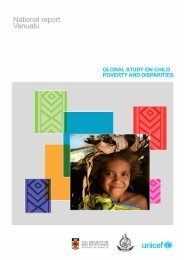A Strategic Assessment of the Children's Services Industry
A Strategic Assessment of the Children's Services Industry
A Strategic Assessment of the Children's Services Industry
- No tags were found...
Create successful ePaper yourself
Turn your PDF publications into a flip-book with our unique Google optimized e-Paper software.
STRATEGIC ASSESSMENT OF THE CHILDREN’S SERVICES INDUSTRYExtensive consultation was undertaken with each community to determine <strong>the</strong> need for a childcare services and outline issues <strong>of</strong> viability. Of particular importance was <strong>the</strong> need to consultwith <strong>the</strong> preschool services government council regarding <strong>the</strong>ir increased responsibility intaking on <strong>the</strong> governance for <strong>the</strong> proposed child care component <strong>of</strong> <strong>the</strong> service.A highlight <strong>of</strong> this approach was <strong>the</strong> provision <strong>of</strong> a child care service for families whoo<strong>the</strong>rwise were dependent on private/ informal arrangement for <strong>the</strong> care <strong>of</strong> children. Ofparticular importance was <strong>the</strong> positive impact for <strong>the</strong> community in being able to allow:• pr<strong>of</strong>essional women (nurses and teachers) to return to <strong>the</strong> workforce and thusovercome skill shortages in country locations• partners <strong>of</strong> farmers experiencing drought being able to return to <strong>the</strong> workforce toprovide an income for <strong>the</strong> familyAn ongoing challenge is <strong>the</strong> need to maintain strict budget scrutiny because <strong>of</strong> <strong>the</strong> finemargins <strong>of</strong> viability <strong>of</strong> <strong>the</strong>se small services. The Rural Care Worker Model cost efficiencieshave been dependent on <strong>the</strong> establishment <strong>of</strong> a unique administrative arrangement whereChild care Benefits payments are administered centrally.The services were implemented over two periods. The Rural Integrated <strong>Services</strong> (15 – 30care places) was established in <strong>the</strong> early to mid 1990s. The Rural Care Worker Model (7 – 12care places) was established in 2002.Learning Toge<strong>the</strong>rLearning Toge<strong>the</strong>r is an early literacy and learning programme for families with childrenunder four years <strong>of</strong> age. It is also a family and community support programme.Learning Toge<strong>the</strong>r aims to connect and engage with <strong>the</strong> ‘hardest to reach’ families who arenot using o<strong>the</strong>r children’s or family services. Learning Toge<strong>the</strong>r Coordinators work toconnect with families, build respectful relationships with <strong>the</strong>m, build and support parentsunderstanding <strong>of</strong> <strong>the</strong>ir children’s learning and improve children’s literacy learning. Eachprogramme has developed according to agreed values and principles and operates from astrength-based perspective.It is not an ‘<strong>of</strong>f <strong>the</strong> shelf’ programme that looks <strong>the</strong> same in each location. Learning Toge<strong>the</strong>ractivities are developed by Learning Toge<strong>the</strong>r Coordinators in each location, and inconsultation with families, to meet <strong>the</strong> needs <strong>of</strong> families and communities.Each Learning Toge<strong>the</strong>r programme has developed strong connections with a range <strong>of</strong>interagency partners to enhance <strong>the</strong>ir work with parents. Families feel more comfortable toseek advice and support when needed if <strong>the</strong>y have developed strong relationships withpr<strong>of</strong>essionals. Each programme has developed a range <strong>of</strong> activities for families incollaboration with o<strong>the</strong>r agencies such as Children, Youth and Women’s Health <strong>Services</strong>,Community Health, hospitals and Families SA. Activities include: facilitated playgroups, <strong>the</strong>development <strong>of</strong> take home literacy packs, parent study groups, family outings, healthycooking sessions, library visits, parent education groups, and parent use <strong>of</strong> digital technologyto make books for and about <strong>the</strong>ir children.Staff from o<strong>the</strong>r agencies report that working in Learning Toge<strong>the</strong>r enables <strong>the</strong>m to connectwith families who would not usually access <strong>the</strong>ir services. Learning Toge<strong>the</strong>r Coordinatorssee o<strong>the</strong>r pr<strong>of</strong>essionals (speech pathologists, social workers, occupational <strong>the</strong>rapists etc) ashaving skills and knowledge to support families that <strong>the</strong>y do not have. Families benefit from62
















